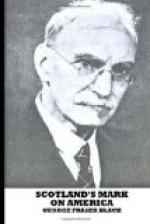Of the fifty-six Signers of the Declaration of Independence, no less than nine can be claimed as directly or indirectly of Scottish origin. Edward Rutledge (1749-1800), the youngest Signer, was a son of Dr. John Rutledge who emigrated from Ulster to South Carolina in 1735. The Rutledges were a small Border clan in Roxburghshire. William Hooper (1742-1790), was the son of a Scottish minister, who was born near Kelso and died in Boston in 1767. Hooper early displayed marked literary ability and entered Harvard University when fifteen years of age. At twenty-six he was one of the leading lawyers of the colony of North Carolina. George Ross (1730-79), was also of Scottish parentage. His nephew’s wife, Elizabeth (Griscom) Ross (1752-1832), better known as “Betsy Ross,” was maker of the first national flag. Matthew Thornton (1714-1803), the distinguished New Hampshire statesman and physician, was brought to this country from the north of Ireland by his father when about three years of age. He accompanied the expedition against Louisburg in 1745, was President of the Provincial Convention in 1775 and Speaker in January, 1776. In September, 1776, he was elected to Congress, and in November following signed the Declaration of Independence, although he had not been one of the framers. Thomas McKean (1734-1817), was a great-grandson of William McKean of Argyllshire who moved to Ulster about the middle of the seventeenth century. He was a member of Congress from Delaware (1774-83), Chief Justice of Pennsylvania (1777-99), and Governor of the state from 1799 to 1808. George Taylor (1716-81), described as the son of a clergyman and “born in Ireland,” was most probably an Ulster Scot. He was a member of the Provincial Assembly of Pennsylvania from 1764 to 1770 and again in 1775. James Wilson (1742-1798), whose fame was to become as wide and lasting as the nation, was born in St. Andrews, the old university city of Fifeshire. He was a Delegate to Congress from Pennsylvania in 1776, Member of the Constitutional Convention of 1787, and Associate Justice of the United States Supreme Court from 1789 till his death. He strongly advocated independence as the only possible means of escape from the evils which had brought the various commonwealths into such a state of turmoil and dissatisfaction. Philip Livingston (1716-1778), grandson of Robert Livingston, the first of the American family of the name, was Member of Congress from New York in 1776. “His life was distinguished for inflexible rectitude and devotion to the interests of his country.”
Last but greatest of all to be mentioned is the Rev. John Witherspoon (1722-94). Born in Yester, Scotland, educated in Edinburgh, minister in Paisley, he was called in 1768 to be President of the College of New Jersey, now Princeton University. He said he had “become an American the moment he landed.” He took an active part in the public affairs of the colony of New Jersey, and in the convention which met




